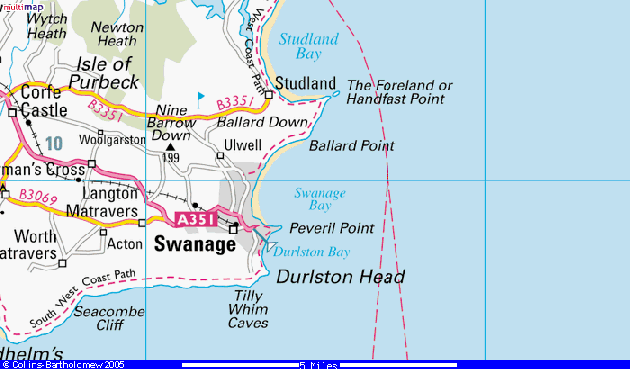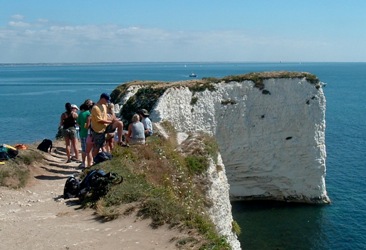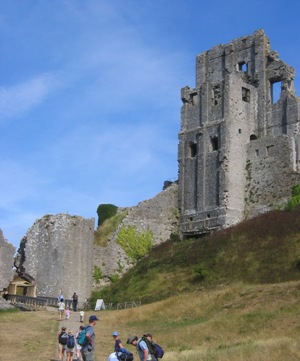The Real Jurassic Park: Geological Explorations in Southwest England
University of Washington, Tacoma
TESC 417: Summer 2006
The Real Jurassic Park: Geology field course along the south coast of England (TESC 417)
Home
Location: Swanage
Introduction:
July 28, 2006--Swanage, located on the Isle of Purbeck, was the first stop on our two-week journey along the southwest coast of England. We were fortunate to have wonderful
accommodations at the Lesson House Field Study Centre--one mile from the most easternly end of the Jurassic World Heritage Site and the beginning of our walk back in time.
The exposed rocks at this eastern end of the Jurassic Coast were laid down during the Cretaceous age, progressively getting older as we moved west along the
coast.
We enjoyed four nights in Langton Matravers (just west of Swanage), taking day trips to Durdle Door, Ballard Down, Old Harry Rocks, Durlston Country Park, Corfe Castle, Kimmeridge Bay, Stair Hole and Lulworth Cove.
We saw stunning views and searched endlessly for fossils--with pretty good success, especially Nels (aka Fossil Man). We learned lots about the the geology of the area--we
studied the rock formations, the tilts and folds of the beds, the age of the rocks, where they were quarried, and how the underlying geology affects the
surface land. We had the chance to visit an authentic castle at the ruins of Corfe Castle--for many of us, it was a first.
Detail Map:

Highlights:
During our visit to Swanage, our class stayed at the Leeson House Field Studies Centre located in Langton Matravers in Dorset,
about a mile from Swanage. We were treated to some beautiful scenery at Old Harry Rocks, a wonderful presentation at Durlston Country Park and a glimpse into
old-world England at the ruins of Corfe Castle.
Synopsis of Area:
At the far eastern end of the World Heritage Site, off Ballard Down, sits Old Harry Rocks. These rocks are dramatic landforms of Cretaceous chalk stacks and arches.
These rocks, which were once a continuous band of chalk that ran through south Dorset, have been eroded over the years by
the action of wind and waves. The sea attacked the weaker areas in the rock which caused the formation of arches and, with more time, caused the collapse of some of
the arches leaving isolated stacks.
The chalk in this area was formed during the Cretaceous period, between 140 and 165 million years ago. During the Cretaceous period, the sea level rose and rocks
formed in marine environments. Later, the earth movements tilted the rocks to the east and the layers were eroded. (Brunsden, 13)
 UWT Class at Old Harry Rocks
UWT Class at Old Harry Rocks
Summary:
After having acquainted ourselves with England and the small town of Swanage, we were off on our first expedition. Friday morning, July 28,
we all woke, bright eyed and ready for action. Up at 7:00 a.m. sharp for breakfast, a good one at that, and we loaded into the van and headed off in search of cliffs of
Cretaceous chalk. Our first stop was Ballard Down and Old Harry Rocks, located at the far-eastern end of the Jurassic World Heritage Site. We were amazed at the
beautiful white cliffs along the coastline--they were natural scuptures of columns and cliffs of white chalk with beautiful, graceful arches. The chalk consists of
calcium carbonate laid down in the Cretaceous age--approximately 140 - 165 million years ago.
Our next stop was Durlston Country Park where we were treated to an overview by Katie, one of the park's guides. Durlston Country Park is a 280-acre nature reserve
stretched along the Purbeck coast and is part of the Jurassic World Heritage Site. After hiking the park hills, tired and hungry, we headed back to Lesson House for
good food and a game of badminton and ping pong.
 Heidi, Lisa, Jenny & Raquel at Old Harry
Heidi, Lisa, Jenny & Raquel at Old Harry
Saturday morning brought exciting adventures at the ruins of Corfe Castle--a dramatic ruin with a history spanning over a 1,000 years. A skeleton of
what once was one of the most impregnable fortifications of its day, Corfe was no disappointment. It sits at the top of a steep conical hill overlooking a gap in the Purbeck
Hills and the town of Corfe on the Isle of Purbeck. Corfe Castle was built in 1050 by William the Conqueror. He situated it there due to its natural defensive location.
Later that day we visited Kimmeridge Bay and the Kimmeridge oil well.
Sunday brought us to Durdle Door and Lulworth Cove which had some of the most beautiful views and incredible rock formations that we saw along the coast.
 Nels and Gus at the base of the Keep at Corfe Castle
Nels and Gus at the base of the Keep at Corfe Castle
Links to Related Projects:
The Cretaceous Chalk in Southern England. By Brieanna Graham
Building England's Castles. By Kathy Deraitus
Geology and Tourism on the South England Coast. By Jenny Ripatti
Holy Architecture!: Cathedrals, Abbeys, and Parish Churches of Southwest England. By Lisa Green
World Heritage: Conservation Efforts in the United Kingdom and Ireland. By Jeanine Riss
Geology, Landscapes, and Land Use of Dorset and East Devon. By Angus Leger
Other Related Links:
The Lesson House Field Study Centre
Swanage Town Council
References and Acknowledgements:
-- Brunsden, Denys. The Official Guide to the Jurassic Coast, Dorset and East Devon Cost World Heritage Site. Coastal Publishing. Wareham, England, 2003.
-- Detail Map: 2006 Multimap.com. September 2, 2006. http://www.multimap.com
-- Dorset County Council (2006). Jurassic Coast. September 22, 2006. http://www.jurassiccoast.com/index.jsp
-- Our thanks to the wonderful people at Lesson House for making our stay a memorable one with interesting facts about the house, great food and helpful staff.
An extra thanks to those who loaned us the computer power cord--without it, this site may not have been possible.
Home

 UWT Class at Old Harry Rocks
UWT Class at Old Harry Rocks Heidi, Lisa, Jenny & Raquel at Old Harry
Heidi, Lisa, Jenny & Raquel at Old Harry Nels and Gus at the base of the Keep at Corfe Castle
Nels and Gus at the base of the Keep at Corfe Castle